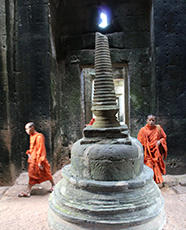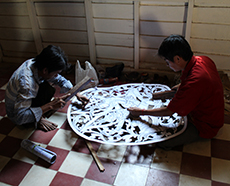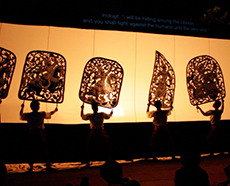Where Did You Go?
I traveled to Siem Reap, Cambodia over winter break for a duration of 10 days. Each day, I visited ancient temples in the region of Angkor, ranging from 7-14 kilometers from downtown Siem Reap. Transportation to each destination was provided by a tuk-tuk driver, which is essentially a motorcycle or scooter operated by the driver with a carriage attached. While traveling through downtown Siem Reap, I was fortunate enough to visit Wat Bo, a Theravada Buddhist temple built during the 18th century, located only 900 meters from my hotel. This particular temple depicts mural scenes of the Reamker, the Khmer version of the Indian epic poem, the Ramayana.
Why Did You Chose Your Destination?

The region of Angkor also sheds light on the emergence of Sbek Thom. The poses of the characters rendered on these large leather figures are similar to the battle scenes sculpted on the bas reliefs of Angkor. Movements of these large leather figures also emulate the style of dancers involved with the royal ballet during the Angkor period, not to mention the parallels between costume, crown decorations and jewelry displayed in both the royal ballet and Sbek Thom. The royal ballet traditionally used a pinpeat ensemble to provide music for each performance, which has also been implemented into the performance of the Reamker. Based on this evidence, it is understood that Sbek Thom most likely developed during the Angkor period (12th century).Siem Reap is the ideal location for research on the art of Nang Sbek Thom, or large leather figures in Khmer. Sbek Thom incorporates the Buddhist narrative of the Reamker, the primary text for Khmer shadow theatre. These large leather figures are still carved today by puppet masters at Wat Bo. Subsequently, performances of the Reamker are also held at Wat Bo, produced by the organization Cambodian Living Arts. As a HAVC major, focusing on Southeast Asian art and visual culture specifically, I became interested in the mechanisms of Sbek Thom after taking an intro course with Prof. Boreth Ly. These large leather figures are more than shadow play or forms of cultural entertainment. These puppets synchronize aspects of dance, music and storytelling associated with the Reamker, conducting the entire performance based on their movement and direction in relation to the audience.
What Did You Learn?
The main characters depicted in the Reamker are Preah Ream (Rama), Neang Seda (Sita), Preah Leak (Lakshmana), Hanuman and Krong Reap (Ravana). Before the performance, all members of the production are encouraged to participate in Sampeah Kru, the blessing ceremony, which bestows protection from evil spirits and allows for the performers to thank their teachers of Sbek Thom. During the ceremony, presentations of Shiva, Vishnu and the Ascetic are placed in front of the screen. These figures are praised with offerings, burning candles and incense. This ceremony is designed to bless all the performers of the Reamker, but also the members of the audience who witness this sacred story.
From 1970-1993, Sbek Thom practically vanished in Siem Reap due to outbreaks of war. In current times of peace, Sbek Thom has steadily been integrated back into Khmer society. Today, select episodes of the narrative are chosen in order to accommodate the growing presence of tourism in Cambodia, making the Reamker more accessible for international visitors who want to know more about Cambodian arts. These renditions usually last about 80-90 minutes, presenting highlights from the Enthachit battle. During my stay at Wat Bo, I witnessed the “Construction of the Causeway” where Preah Ream, Preah Leak and Hanuman seek to build a bridge to the kingdom of Langka in order to rescue Neang Seda from Krong Reap.
The Reamker usually has two male narrators, considered to be the most important performers of Sbek Thom. Most narrators are often teachers of Sbek Thom and leaders of the troupe, requiring each narrator to structure the dialogue throughout the entirety of the performance. Given the context of these distinct gender roles, I was pleased to see a female narrator in the performance at Wat Bo. This demonstrates how the reintroduction of Sbek Thom in Khmer society has also altered the traditions and rituals associated with the Reamker, rendering these cultural forms of art and knowledge more accessible to all citizens of Cambodia.
What Was Your Most Memorable Experience?

